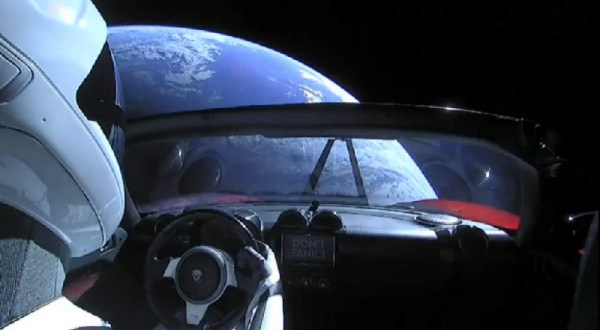There’s a Starman, waiting in the sky. He’d like to come and meet us, but he’ll have to wait several million years until the Yarkovsky effect brings him around to Earth again.
In case you’ve been living under a rock for the past few weeks, SpaceX recently launched a car into space. This caused much consternation and hand-wringing, but we got some really cool pictures of side boosters landing simultaneously. The test launch for the Falcon Heavy successfully lobbed a Tesla Roadster into deep space with an orbit extending out into the asteroid belt. During the launch coverage, SpaceX said the car would orbit for Billions of years. This might not be true; a recent analysis of the random walk of cars revealed a significant probability of hitting Earth or Venus over the next Million years.
The analysis of the Tesla Roadster relies on the ephemerides provided by JPL’s Horizons database (2018-017A), and predicts the orbit over several hundred years. In the short term — a thousand years or so — there is little chance of a collision with anything. In 2091, however, the Tesla will find itself approaching Earth, and after that, the predicted orbits change drastically. As an aside, we should totally bring the Tesla back in 2091.
Even though the Tesla Roadster, its payload adapter, and the booster are inert objects floating in space right now, that doesn’t mean there aren’t forces acting on it. For small objects orbiting near the sun, the Yarkovsky effect is a huge influence on the orbit when measured on a timescale of millennia. In short, the Yarkovsky effect is a consequence of a spinning object being heated by the sun. As an object (a Tesla, or an asteroid) rotates, the side facing the sun heats up. As this side faces away from the sun, this heat is radiated out, imparting a tiny, tiny force. This force, over a period of millions of years, can send the Tesla into resonances with other planets, eventually sending it crashing into Earth, Venus, or the Sun.
The authors of this paper find there is a 6% chance the Tesla will collide with Earth and a 2.5% chance it will collide with Venus in the next one Million years. In three Million years, the probability of a collision with Earth is 11%. These are, according to the authors, extremely preliminary calculations and more observations are needed. If the Tesla were to hit the Earth, it’s doubtful whatever species populates the planet would notice; the mass of the Tesla is only 1250 Kg, and Earth flies through meteoroids weighing that much very frequently.













